Employment references fall into several distinct categories—professional references, character references, academic references, and verification-only contacts—each serving specific purposes in the hiring process. Understanding which type of employment reference carries the most weight for different positions helps both employers make informed hiring decisions and job seekers prepare strategic reference lists that strengthen their candidacy.
Key Takeaways
- Professional references from direct supervisors carry the most weight in employment decisions, providing firsthand insight into work performance and job-specific competencies.
- Character references focus on personal qualities and integrity rather than technical skills, making them valuable for entry-level positions or career changers with limited work history.
- Peer references offer unique perspectives on collaboration abilities and day-to-day work habits that supervisors may not observe directly.
- Academic references are essential for recent graduates and early-career professionals who lack extensive employment history but can demonstrate potential through educational achievements.
- Employment verification references simply confirm dates, titles, and eligibility for rehire without providing qualitative assessments of performance.
- Most employers check 2-3 references before extending job offers, with professional references from recent positions prioritized over older or personal contacts.
- Reference types should align with the position level—executive roles require senior-level professional references, while entry-level positions may accept academic or character references.
- Background check reference verification differs from traditional reference checks by focusing on factual accuracy rather than subjective performance evaluations.
- Strategic reference selection means matching reference types to job requirements, choosing contacts who can speak to specific skills mentioned in the job description.
Understanding Employment References in 2025
Employment references serve as third-party validations of a candidate's qualifications, work ethic, and professional reputation. In today's competitive hiring landscape, references provide employers with critical insights beyond what resumes and interviews reveal. The types of employment references available to hiring managers vary significantly in their format, depth, and reliability. This makes it essential to understand which reference categories deliver the most valuable information for different hiring scenarios.
The employment verification process has evolved considerably with technology. Yet personal references remain irreplaceable for assessing cultural fit and soft skills. Modern reference checking combines traditional phone conversations with digital verification platforms, background check services, and even social media validation. Despite these technological advances, the fundamental categories of employment references have remained consistent. However, their relative importance shifts based on industry, position level, and organizational culture.
For HR professionals and hiring managers, developing a systematic approach to categorizing and utilizing different reference types improves hiring outcomes. It also reduces time-to-fill metrics. For job seekers, understanding what employers seek from various reference types enables more strategic selection of reference contacts. These contacts can then authentically advocate for their candidacy.
EXPERT INSIGHT: As an HR professional, I have come to understand that references are never "just a box to check" – they’re the point in the hiring process where, finally, we might see the real person behind the resume. Rather, the most impressive references I have received in my life have not simply asserted "They’re great," but have instead told me about moments in which they observed candidates under pressure, in conflict, in failure, and in growth. And for these reasons, I now advise candidates to think about their references with purpose: an old boss who saw you take on new responsibilities, a colleague with whom you collaborated, or a mentor to whom you meant something. By recognizing references for what they really are: a process shared by HR professionals and job candidates alike, they cease to be simply a box to check, and instead become something truly meaningful. - Charm Paz, CHRP
Professional References: The Gold Standard
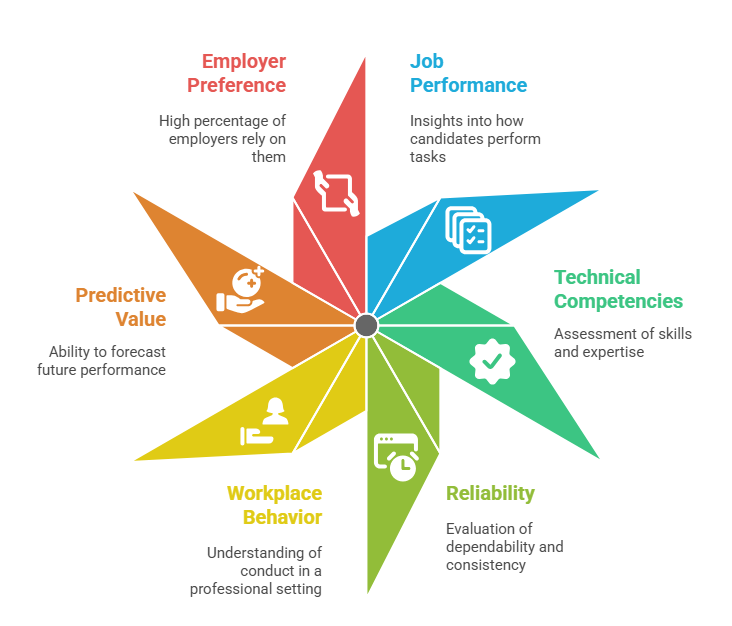
Professional references represent the most valuable category of work references for most hiring decisions. These contacts have directly supervised, managed, or worked alongside the candidate in a professional capacity. They can speak authoritatively about job performance, technical competencies, reliability, and workplace behavior. Unlike character references that focus on personal attributes, professional references provide concrete examples of how candidates perform under actual working conditions.
The strength of professional references lies in their ability to predict future performance based on observed past behavior. When a former supervisor describes how a candidate handled a difficult client situation or managed competing deadlines, hiring managers gain evidence-based insights. These insights cannot be replicated through interviews alone. Employment background check references often begin with professional contacts because they offer the most relevant data for assessing job fit and minimizing hiring risks.
Research from the Society for Human Resource Management indicates that 87% of employers contact professional references before making final hiring decisions. Direct supervisors are weighted most heavily in this process. Professional references become particularly critical for mid-to-senior level positions where demonstrated leadership, strategic thinking, and industry expertise must be verified. These capabilities need verification through credible sources who have witnessed them firsthand.
Direct Supervisor References
Direct supervisor references provide the most comprehensive assessment of a candidate's work performance. They can speak to strengths, development areas, and overall contribution to previous organizations. These references carry exceptional weight because supervisors have direct accountability for employee performance and typically conduct formal evaluations. Former managers can address specific questions about attendance, ability to meet deadlines, response to feedback, and progression during employment tenure. When supervisor references align consistently with a candidate's self-presentation during interviews, employers gain confidence in their hiring decision.
Peer and Colleague References
Peer references offer unique perspectives on collaboration skills, communication style, and day-to-day work habits that supervisors may not directly observe. Colleagues who worked alongside candidates on projects or teams can validate claims about teamwork abilities, problem-solving approaches, and interpersonal effectiveness. These references become particularly valuable for positions requiring extensive cross-functional collaboration or team-based project work.
While peer references carry less weight than supervisor references for assessing overall performance, they provide authentic insights into how candidates function as team members. Hiring managers often seek peer references to supplement supervisor feedback. This creates a more complete picture of the candidate's workplace presence and contribution style.
Character References: Beyond Professional Competence
Character references focus on personal qualities rather than job-specific technical skills. These references typically come from individuals who know the candidate well in non-employment contexts. They become particularly relevant for positions requiring high ethical standards, community engagement, or roles where trustworthiness outweighs technical expertise. Character references are valuable assessment tools that complement professional references in the hiring process.
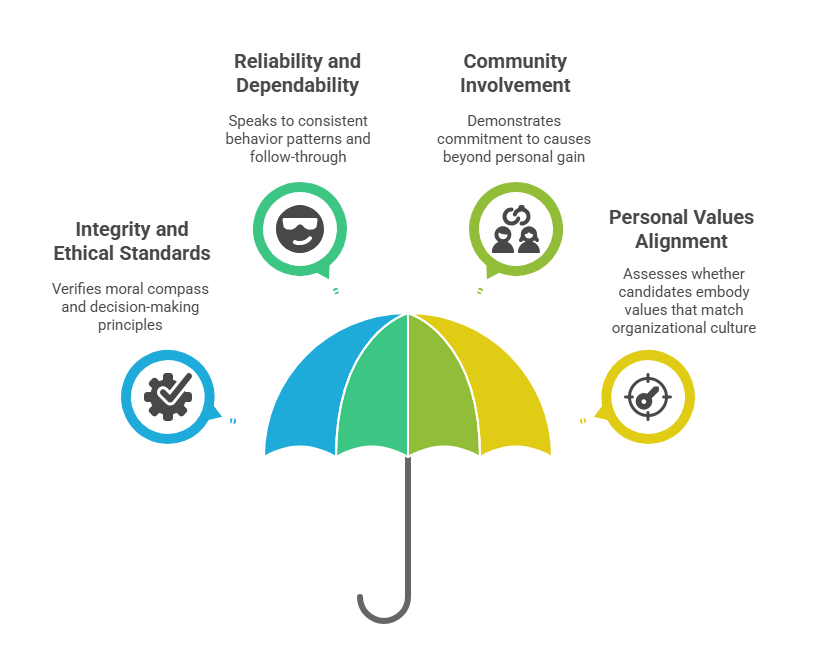
- Integrity and ethical standards: Character references verify a candidate's moral compass and decision-making principles in various situations.
- Reliability and dependability: These contacts can speak to consistent behavior patterns and follow-through on commitments over time.
- Community involvement: References from volunteer coordinators or civic leaders demonstrate commitment to causes beyond personal gain.
- Personal values alignment: Character references help assess whether candidates embody values that match organizational culture and mission.
Not all positions require character references, but certain industries place substantial emphasis on personal integrity verification. Financial services, healthcare, education, and positions involving vulnerable populations often request character references to ensure candidates meet ethical standards beyond mere job qualifications.
Academic References: Validating Potential
Academic references come from professors, academic advisors, research supervisors, or educational administrators who can speak to a candidate's intellectual capabilities. They prove essential for recent graduates, early-career professionals, and candidates pursuing roles that heavily emphasize analytical thinking. For candidates with limited professional experience, these references demonstrate potential, work ethic, and foundational competencies that predict workplace success.
Professors can describe how students approached complex projects and collaborated with peers on group assignments. They can also explain how students demonstrated initiative beyond coursework requirements and responded to challenging intellectual demands. These behaviors translate directly to workplace competencies valued by employers hiring for analytical, research-intensive, or technical positions. Graduate-level academic references carry particular weight when candidates pursue specialized roles requiring advanced expertise.
What Are the Different Types of Employment References Employers Use?

Employers deploy various employment reference approaches depending on position requirements, organizational size, industry regulations, and hiring urgency. The reference checking process typically combines multiple reference types to create comprehensive candidate assessments. Understanding this multi-faceted approach helps both hiring professionals optimize their reference strategies and job seekers prepare appropriate reference contacts.
The most common types of employment references employers use include formal structured references, informal conversational references, written reference letters, and automated employment verification services. Each approach serves distinct purposes within the broader hiring process. Formal structured references follow standardized question sets ensuring consistent candidate evaluation across all applicants. Informal conversational references allow for organic discussion that may reveal insights not captured through rigid questioning.
Different industries emphasize different reference approaches based on regulatory requirements and risk profiles. Healthcare organizations conduct extensive reference checks including character references due to patient safety concerns. Technology companies may prioritize peer references and portfolio validation over traditional supervisor references. Government positions often require security clearances involving comprehensive background investigations that extend far beyond standard employment references.
Structured Professional References
Structured professional references follow standardized question sets designed to evaluate specific competencies, behaviors, and performance metrics consistently across all candidates. HR departments develop these structured approaches to reduce bias, ensure legal compliance, and enable objective comparison between finalists. The standardized format ensures all candidates receive equitable evaluation based on job-relevant criteria rather than subjective impressions. Many organizations combine structured questioning with open-ended follow-ups that allow references to provide additional context or examples not captured by standardized queries.
Conversational Informal References
Conversational informal references involve open-ended discussions between hiring managers and reference contacts without rigid question structures. This approach allows references to share observations, stories, and insights in their own words. The flexibility enables hiring managers to probe areas of concern, request specific examples, or explore topics that arise organically. However, informal references risk inconsistency across candidates and potential legal exposure if discussions venture into protected characteristics. Best practices combine conversational approaches with documented summaries capturing key points for hiring file documentation.
Employment Verification vs. Reference Checks
Employment verification confirms factual information such as dates of employment, job titles, salary history (where legally permissible), and eligibility for rehire. Reference checks assess qualitative aspects of performance, work habits, interpersonal skills, and overall job fit. While verification answers "Did this person work here in this role during these dates?", reference checks address "How well did this person perform?" and "Would you rehire them?"
| Process | Information Provided | Source | Purpose |
| Employment Verification | Dates, titles, salary (if permitted), rehire eligibility | HR departments, automated systems | Confirm resume accuracy |
| Reference Checks | Performance quality, skills, work habits, accomplishments | Direct supervisors, colleagues, clients | Assess job fit and predict performance |
| Background Check Reference Verification | Criminal records, credit history, education confirmation, employment history | Third-party screening companies | Ensure candidate meets safety and compliance requirements |
Many large organizations maintain policies limiting reference responses to verification-only information due to liability concerns. When former employers restrict references to dates and titles, hiring managers must seek alternative reference sources who can provide qualitative assessments.
Which Type of Employment Reference Is Most Valuable?
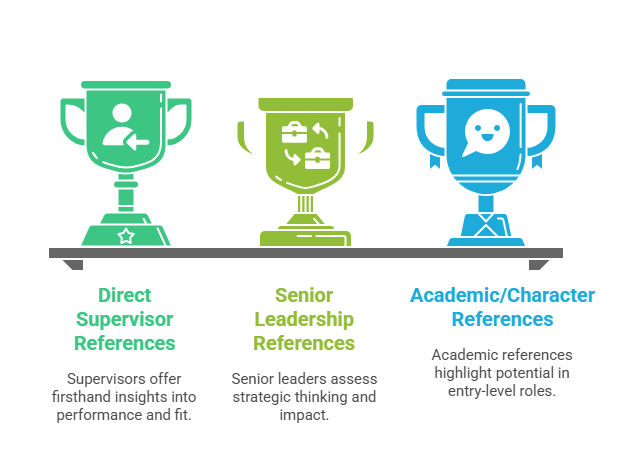
The most valuable type of employment reference varies based on position level, candidate experience, industry requirements, and specific role demands. However, professional references from direct supervisors in recent positions consistently rank as the most influential reference type across industries and position levels. Supervisors possess firsthand knowledge of performance quality, reliability, skill application, and cultural fit—the exact information hiring managers most need to make confident decisions.
For entry-level positions, academic references or character references may carry equal or greater weight than limited professional references. This is particularly true when candidates demonstrate high potential despite minimal work history. Conversely, executive-level positions require senior leadership references who can credibly assess strategic thinking and organizational impact. The reference hierarchy shifts based on what the position demands and what the candidate's career stage can realistically provide.
Industry context significantly influences reference value assessment. Creative fields may prioritize client references and portfolio validation over traditional supervisor references. Sales roles heavily weight references that can quantify revenue generation and client relationship capabilities. Technical positions emphasize references from leads who can assess code quality or technical problem-solving approaches. Job seekers maximize reference impact by strategically selecting contacts whose perspectives align with position priorities.
How Many Employment References Do Employers Typically Check?
Most employers check 2-3 employment references before extending job offers, though this number varies based on several factors. Entry-level positions may involve checking only one or two references, while senior leadership roles often require 5-7 references. Standard practice requests candidates provide 3-5 reference contacts, giving employers options if initial references prove unreachable or less informative than expected.
- Entry-level positions
- Mid-level professional roles
- Senior management positions
- Executive leadership roles
- Government security clearances
The quality of reference conversations matters more than quantity. One detailed discussion with a direct supervisor who provides specific performance examples delivers greater value than three superficial conversations. Candidates should prepare more references than minimum requirements suggest to demonstrate preparation and provide backup options.
Best Practices for Selecting Employment References
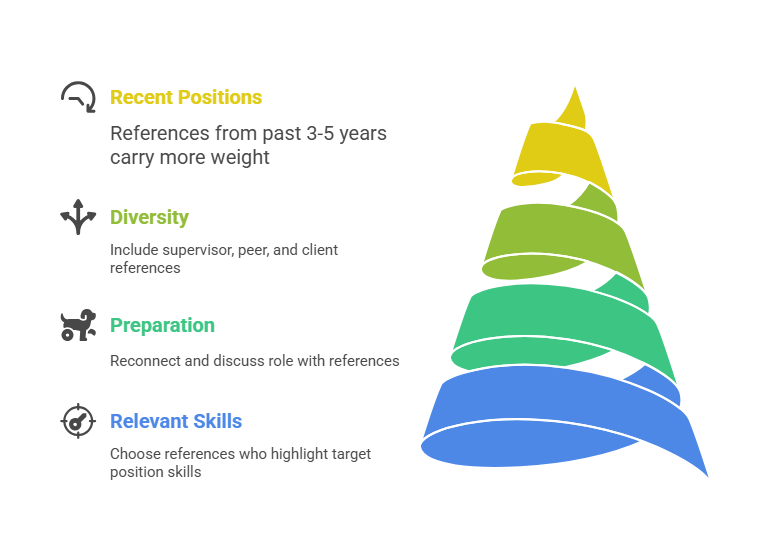
Strategic reference selection significantly impacts hiring outcomes for job seekers and evaluation quality for employers. Job seekers should choose references who can speak specifically to skills and accomplishments relevant to target positions. A direct supervisor who managed your daily work provides more valuable insights than a company executive you met twice, regardless of title disparity.
Preparation separates effective references from mediocre ones. Before providing reference contact information, candidates should reconnect with potential references, request permission, explain the target role, and discuss which aspects of your shared experience most relevantly support the opportunity. This preparation ensures references can provide specific, relevant examples rather than vague generalities. It also refreshes their memory of your work together, particularly important for references from several years ago.
Diversity among reference types strengthens candidate assessment. Rather than three supervisor references from similar roles, consider including one supervisor reference, one peer reference, and one client or cross-functional partner reference. This variety provides a multidimensional perspective on your capabilities, work style, and professional impact. Professional references should come from recent positions—ideally within the past 3-5 years—because older observations carry less weight for predicting current capabilities.
Common Employment Reference Mistakes to Avoid
Both job seekers and employers make critical errors during the reference process that can undermine hiring decisions or damage professional reputations. Understanding these common mistakes helps all parties navigate reference checks more effectively. Avoiding these pitfalls protects relationships, ensures legal compliance, and maximizes the value of reference information.
Job Seeker Mistakes:
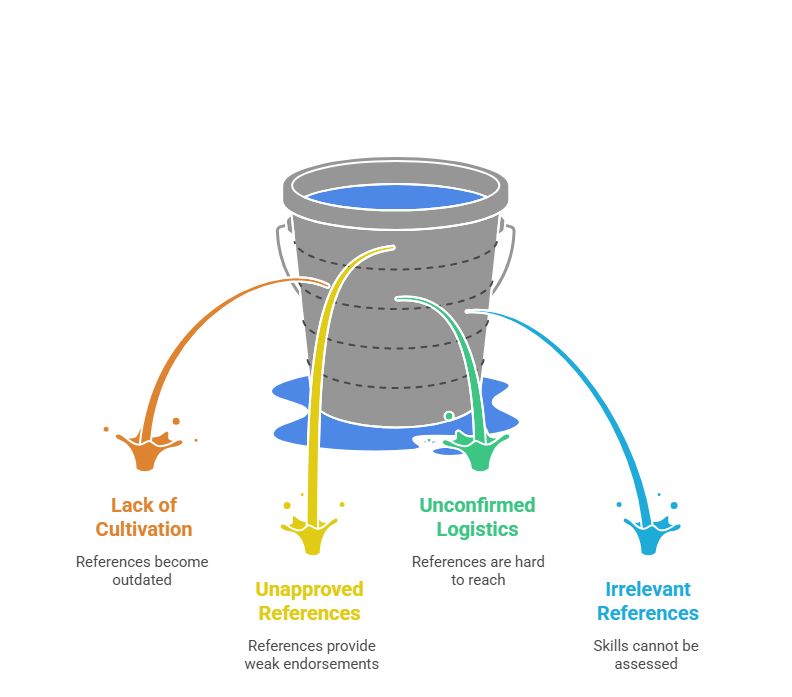
- Failing to maintain professional relationships: Reference cultivation should be ongoing throughout your career, not scrambled together when job searching begins through regular LinkedIn engagement and professional check-ins.
- Listing references without permission: Unprepared references may not recall details or provide lukewarm endorsements due to surprise when hiring managers contact them unexpectedly.
- Not confirming contact preferences: Always explain the opportunity and confirm preferred contact methods, time zones, and availability before sharing reference information.
- Providing irrelevant references: A supervisor who managed you in a customer service role five years ago cannot credibly assess your current data analytics capabilities.
Employer Mistakes:
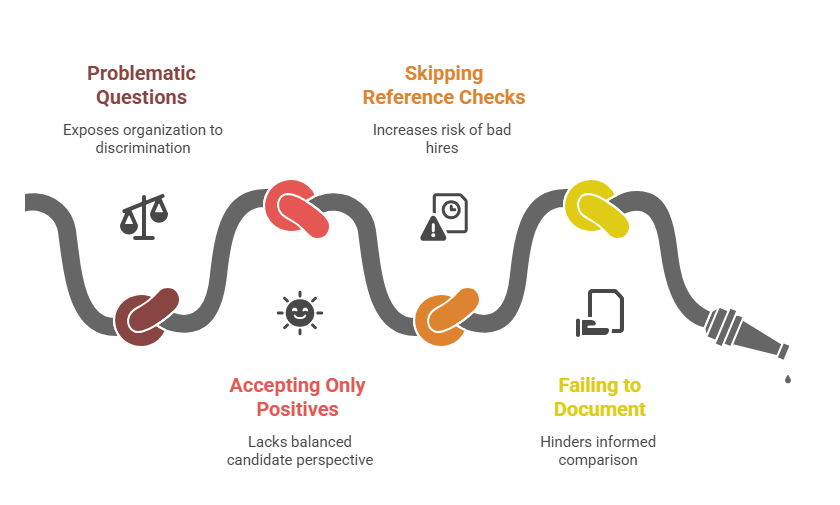
- Asking legally problematic questions: Avoid inquiries about protected characteristics, medical history, or other topics that expose the organization to discrimination claims.
- Accepting only positive information: Effective reference checking probes for development areas and examples of challenge, not just strengths, to gain balanced perspectives.
- Skipping reference checks due to urgency: Time pressure never justifies eliminating this critical risk mitigation step that prevents costly bad hires.
- Failing to document conversations: Thorough documentation protects organizations legally and enables informed comparison across candidates.
Strategic reference management requires proactive planning and ongoing relationship maintenance for job seekers. For employers, it demands structured processes that balance thoroughness with legal compliance. Both parties benefit from treating references as valuable professional assets rather than administrative formalities.
Legal Considerations for Employment References
Employment references exist within complex legal frameworks that vary by jurisdiction. Employers providing references must balance honest assessment with defamation risk exposure. Employers checking references must comply with fair hiring laws, anti-discrimination statutes, and background check regulations including the Fair Credit Reporting Act (FCRA). Understanding these legal boundaries protects all parties and ensures compliant reference processes.
The FCRA regulates consumer reports obtained from third-party background check companies, requiring specific disclosures and candidate permissions before conducting background check reference verification. When employers directly contact references without third-party services, FCRA requirements may not apply, though other employment laws still govern the process. Organizations should consult legal counsel to ensure their reference checking practices comply with federal, state, and local requirements.
Many employers adopt verification-only reference policies limiting information to dates of employment and position titles. This approach minimizes legal exposure but reduces the value of reference information available to hiring organizations. Some jurisdictions have enacted reference immunity laws protecting employers who provide good-faith references from defamation liability. Discrimination laws prohibit reference questions about protected characteristics including age, race, religion, disability, pregnancy, or other protected statuses.
Specialized Reference Types for Specific Industries
Certain industries require specialized reference types beyond standard professional and character references. Healthcare positions often require clinical supervisor references who can assess patient care competencies and adherence to medical protocols. Educational positions require references from administrators or fellow educators who can speak to classroom management. Financial services roles frequently require compliance-focused references that verify ethical conduct and regulatory adherence.
| Industry | Specialized Reference Type | Key Focus Areas |
| Healthcare | Clinical supervisor references | Patient care competencies, medical protocol adherence, bedside manner |
| Education | Administrative or teaching peer references | Classroom management, instructional effectiveness, student engagement |
| Financial Services | Compliance-focused references | Ethical conduct, regulatory adherence, fiduciary responsibility |
Law enforcement and security positions require extensive background investigations including neighborhood canvassing and character witnesses. These go far beyond typical employment references in scope and depth. Understanding industry-specific reference requirements ensures candidates prepare appropriate contacts and employers gather information necessary for compliant hiring decisions.
International Employment References
International hiring introduces additional complexity to employment reference verification. Cultural differences affect how references present information, with some cultures emphasizing modesty while others encourage self-promotion. Language barriers may require translation services or references who speak the employer's primary language. Time zone differences complicate scheduling reference conversations across continents.
Legal frameworks governing employment references vary significantly by country. European Union privacy regulations under GDPR impose strict limitations on personal data sharing that affect reference information. Some countries prohibit former employers from providing anything beyond basic verification, while others require written consent from candidates before any reference discussion. International credential verification services specialize in validating foreign education and employment history when direct reference contact proves difficult.
Employers hiring international candidates should research reference norms for the candidate's home country and adjust expectations accordingly. Candidates with international work experience should proactively address potential reference challenges by offering alternative verification methods. Cultural sensitivity and flexibility ensure international references provide valuable insights despite geographic and regulatory complexities.
Reference Strategies for Career Changers
Career changers face unique reference challenges when transitioning to new industries or roles significantly different from previous experience. Traditional professional references may struggle to assess capabilities for unfamiliar positions. Strategic reference selection becomes critical for demonstrating transferable skills and learning potential. Career changers should identify references who can speak to adaptability, quick learning, and core competencies that apply across roles.
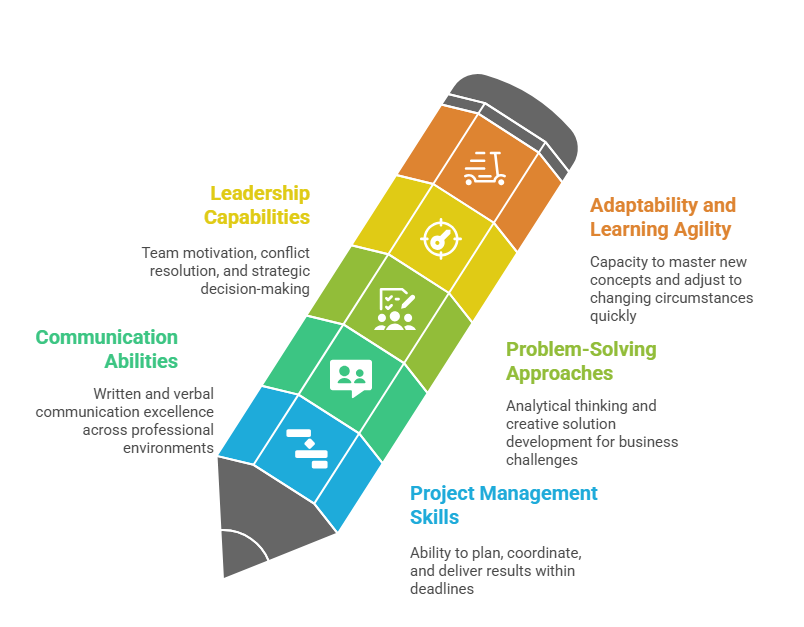
- Project management skills: Ability to plan, coordinate, and deliver results within deadlines regardless of industry context.
- Communication abilities: Written and verbal communication excellence that translates across all professional environments.
- Problem-solving approaches: Analytical thinking and creative solution development applicable to various business challenges.
- Leadership capabilities: Team motivation, conflict resolution, and strategic decision-making that work universally.
- Adaptability and learning agility: Demonstrated capacity to master new concepts and adjust to changing circumstances quickly.
Supplemental references from professional development contexts strengthen career changer applications. Instructors from training programs, bootcamps, or certification courses in the target field provide valuable perspectives on technical skill acquisition. Volunteer experience in the desired industry creates reference opportunities demonstrating genuine interest and foundational capabilities.
Managing Difficult Reference Situations
Not all employment experiences end positively, and some candidates face challenges providing strong professional references from previous positions. Termination, workplace conflicts, or organizational dysfunction can create reference gaps that require strategic navigation. Honesty about difficult situations paired with alternative reference sources protects credibility while addressing employer concerns.
When a direct supervisor relationship ended poorly, consider alternative references from the same organization. Colleagues, clients, or other managers who observed your work can provide professional references without involving the problematic supervisor. Many employers understand that not every workplace relationship succeeds. A single difficult reference among several positive ones rarely eliminates strong candidates.
Reference gaps from positions many years ago matter less than recent references for most hiring decisions. If an older position ended poorly but you've accumulated strong references from subsequent roles, the problematic reference loses relevance. For recent difficult situations, consider including references from contract work, volunteer positions, professional association involvement, or freelance clients. These alternative professional references demonstrate continued capability despite employment challenges.
Conclusion
Understanding the types of employment references and their relative value enables hiring professionals to design effective verification strategies that minimize risk while respecting candidate timelines. Professional references from direct supervisors remain the gold standard for most positions, supplemented by peer, academic, or character references depending on candidate experience and role requirements. Strategic reference selection, thorough preparation, and legal compliance protect all parties while ensuring hiring decisions rest on credible, relevant information. As employment verification continues evolving with technology, the fundamental value of human references who can assess performance quality, cultural fit, and growth potential remains irreplaceable in the 2025 hiring landscape.
Frequently Asked Questions
What's the difference between professional and personal references?
Professional references come from work-related relationships—supervisors, colleagues, or clients who can speak to your job performance and technical skills. Personal references come from non-work relationships like community leaders or mentors who address your character traits and integrity. Most employers prioritize professional references for positions requiring demonstrated expertise.
How many employment references do employers typically check?
Most employers check 2-3 employment references before extending job offers, though this varies by position level and industry. Entry-level positions may involve one or two reference contacts, while senior leadership roles often require 5-7 references. Quality matters more than quantity—one detailed conversation with a direct supervisor delivers more value than multiple generic statements.
Which type of employment reference is most valuable?
Professional references from direct supervisors in recent positions rank as the most valuable because they provide firsthand knowledge of performance quality and reliability. However, the most valuable reference type shifts based on position requirements—academic references matter more for recent graduates, while client references prove critical for sales roles.
Can employers contact references not listed by candidates?
Employers can potentially contact unlisted references, though professional standards typically discourage this practice without candidate notification. Best practice involves asking candidates for additional references if listed contacts prove insufficient. If employers discover concerning information requiring verification, they should inform candidates and allow opportunity for explanation.
Should you include your current employer as a reference?
Including your current employer as a reference is generally inadvisable when conducting a confidential job search, as disclosure could jeopardize your current position. Most hiring managers understand this constraint and don't expect current employer references during early hiring stages. Negotiate timing carefully for final-stage opportunities.
What should you do if you don't have professional references?
Candidates without professional references can leverage academic references from professors, character references from community leaders, or contacts from internships and volunteer work. Consider building professional references through volunteer work, professional association involvement, or freelance projects. Address your reference situation proactively with hiring managers.
How far back should employment references go?
Employment references should typically come from the past 3-5 years to ensure relevance to your current capabilities. References from recent positions carry more weight because industries and technologies evolve. However, a reference from eight years ago who supervised work directly related to your target position may be more valuable than a recent reference from an unrelated role.
What information can former employers legally share in references?
Former employers can generally share truthful, job-related information including dates of employment, positions held, job performance, and rehire eligibility. Many organizations adopt verification-only policies to minimize defamation risk exposure. Former employers cannot share information about protected characteristics or make false statements intended to harm employment prospects.
Additional Resources
- SHRM Guide to Employment Background Checks and Reference Checks
https://www.shrm.org/resourcesandtools/tools-and-samples/toolkits/pages/employmentbackgroundchecks.aspx - Federal Trade Commission: Background Checks and the FCRA
https://www.ftc.gov/business-guidance/resources/using-consumer-reports-what-employers-need-know - The Balance Careers: How to Choose Professional References
https://www.thebalancemoney.com/how-to-choose-professional-references-2063339 - LinkedIn Talent Solutions: Reference Checking Best Practices
https://business.linkedin.com/talent-solutions/resources/interviewing-talent/reference-checking - Department of Labor: Employment Background Checks and the Law
https://www.dol.gov/agencies/odep/publications/fact-sheets/youth-employment-success-obtaining-references
Still have questions?
Get in touch with our team today for a personalized demo and discover how our tailored volume pricing and packages can drive results for your business!
How useful was this page?*
Note: your comments are anonymous. We use them to improve the website. Do not include any personal details.
Visit our FCRA Compliance Tool or leave a message here if you need a response.
From the blog Explore the GCheck Content Hub

Prescription Drugs That Show Up on Drug Tests: A Compliance Guide
4 Dec, 2025 • 18 min read
Seasonal Employee Background Checks: Protecting Your Business During Peak Hiring Periods
4 Dec, 2025 • 22 min read
Background Check for Volunteers vs Employees: Legal Frameworks and Screening Protocol Development
3 Dec, 2025 • 14 min readThe information provided in this article is for general informational and educational purposes only and should not be construed as legal advice or a substitute for consultation with qualified legal counsel. While we strive to ensure accuracy, employment screening laws and regulations—including but not limited to the Fair Credit Reporting Act (FCRA), Equal Employment Opportunity Commission (EEOC) guidelines, state and local ban-the-box laws, industry-specific requirements, and other applicable federal, state, and local statutes—are subject to frequent changes, varying interpretations, and jurisdiction-specific applications that may affect their implementation in your organization. Employers and screening decision-makers are solely responsible for ensuring their background check policies, procedures, and practices comply with all applicable laws and regulations relevant to their specific industry, location, and circumstances. We strongly recommend consulting with qualified employment law attorneys and compliance professionals before making hiring, tenant screening, or other decisions based on background check information.


